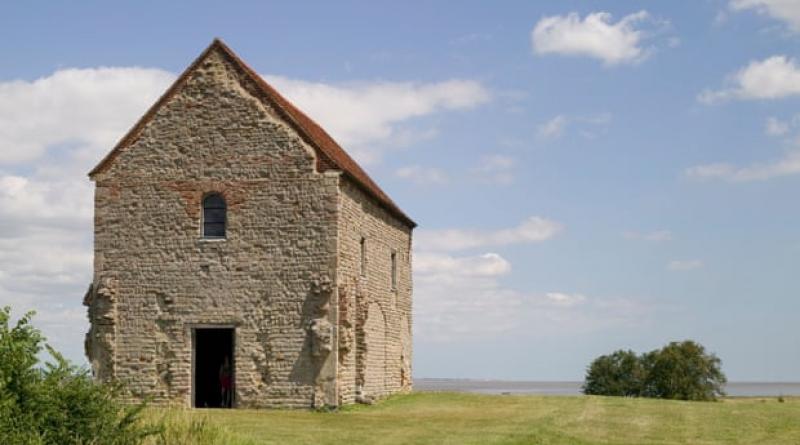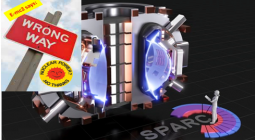Saxon church prays for deliverance from nuclear plant.

Community says boom in renewable energy means Bradwell B in Essex is not needed.
For the 55 years that Tim Fox has worshipped at St Peter-on-the-Wall, his only neighbours have been a farm and a birdwatchers’ shelter.
Now, the tranquil surroundings of the salt marsh and the Essex sea wall at Bradwell-on-Sea are threatened by a new arrival: a sprawling nuclear power station, Bradwell B.
If all goes to plan, the Grade I-listed St Peter-on-the-Wall, built in an abandoned Roman fort in about 660 during the Saxon settlement of Britain, will be an ideal place to watch 10,600 construction workers building the nuclear reactor. “My parents brought me here in 1965 when I was four years old and I can’t remember not coming,” Fox said. “If they build the power station, it would have a devastating effect on us – I don’t think we’d be able to survive the construction.”
Fox is a member of an obscure Christian community called Othona, founded by an RAF chaplain after the second world war, and named after the Roman fort that the chapel was built on, although most of the ruins have been swallowed by the seas around the Blackwater estuary.
“We have about 700 members in Essex,” Fox, Othona’s centre manager, said. “There’s no hierarchy and no restrictions. Anyone who wants to lead can take the daily service. That might be reading a bit of poetry or meditating – anything as long as it’s not inciting hatred or bigotry. It’s open to people of all faiths and none.”
Although Othona is welcoming to visitors, that generosity is not extended to EDF Energy and China General Nuclear Group (CGN), the Franco-Chinese consortium behind the Bradwell B project. “I know this has to be on somebody’s doorstep, but it seems to me that nuclear power isn’t the way to go,” Fox said. “Renewable energy is getting cheaper and there are two wind farms here. This is the driest part of England – you could put a solar farm here.”
Bradwell B was part of David Cameron and George Osborne’s vision of a string of six new nuclear power stations. Hinkley Point C in Somerset is under construction and in December when the government published its energy white paper, it said ministers would reach a decision on “at least one large-scale nuclear project” by 2024.
Although most attention has focused on Sizewell C in Suffolk, Bradwell B could be ready for approval next year. Earlier this month the Environment Agency told CGN that it needed to make at least six changes to the reactor design.
“My view, like a lot of the community, is that we shouldn’t be taking money from the Chinese government,” Fox said, citing the Hong Kong crackdown on opposition politicians and the Chinese government’s genocidal campaign against Uighur Muslims.
Radiation and nuclear waste are other concerns. Further along the Blackwater estuary is Bradwell A, an old Magnox reactor that has been decommissioned.
“It’s encased in some sort of cladding, and they’ll leave that there for 200 years or so for the next generations to worry about. I don’t know what they will do with the waste if they build a new one.”
The Bradwell B proposal is “10 times as big as Bradwell A, and needs a hole in the earth five times the size of Wembley Stadium,” he added. “It will absolutely devastate the sanctuary of the Saxon chapel.”
Electricity demand is expected to double by 2050, but that does not mean nuclear power is necessary, according to Roz Bulleid, deputy policy director at the Green Alliance.
“With Hinkley Point coming online supposedly by 2025 and Sizewell C being lined up, even if we do need new nuclear, do we need this one right now?” she said.
“We would prefer that the government makes a much more concerted effort to avoid the need for power and invest in more electricity storage for renewables.”
Since 2016, the cost of offshore wind power has fallen by about two thirds, she said, costing about £40 per megawatt hour, compared with £90 for Hinkley Point. “Obviously, renewables are more intermittent so you don’t have a steady supply, but all sorts of other options are coming online with storage – pumped storage, batteries, compressed air storage.
“And digital technologies allow us a much more sophisticated management of demand, so you can charge electric vehicles overnight when the wind is blowing but no one’s using power.”
Tom Greatrex, chief executive of the Nuclear Industry Association, said that “all credible assessments” by bodies such as the International Energy Agency, the OECD and Climate Change Committee showed that nuclear power was needed to bolster wind and solar energy to meet the target of zero emissions by 2050.
“We need to have four times the amount of clean power on our system than we do today,” Greatrex said. “Pretending it can be done without zero-carbon nuclear simply increases the reliance on burning fossil fuels, and means more carbon emissions and peril for the planet. Net zero needs nuclear.”
Nuclear power is part of the government’s ‘ten point plan for a green industrial revolution’, he added.
The Climate Change Committee said in 2019 that about 57% of electricity should come from renewable sources, with 38% from low carbon power such as nuclear plants or biomass plants that capture carbon dioxide emissions.
The Bradwell B consortium was approached for comment.
24 January 2021
The Guardian





